The Hydraulic Infinite Linear Actuator offers a new way to generate mechanical linear motion.
Contributed by Magnus Landberg, Landberg Solutions AB and Magnus Sethson, Linköping University, Linköping, Sweden
In the forestry industry, robust and power-dense hydraulics have long played an important role in successful and cost-effective operations. Today, there is also a trend towards larger timber transport vehicles that consume less energy.
One way engineers can keep up with these demands is by taking advantage of a new sort of hydraulic linear actuator technology, embodied in the Hydraulic Infinite Linear Actuator (HILA). It can help improve vehicle aerodynamics, accommodate varying load sizes and weights to raise productivity, and automate dangerous manual tasks to enhance safety. It is also suited for agricultural operations to ensure high-yield and sustainable farming. Here’s a closer look at HILA fundamentals and applications.
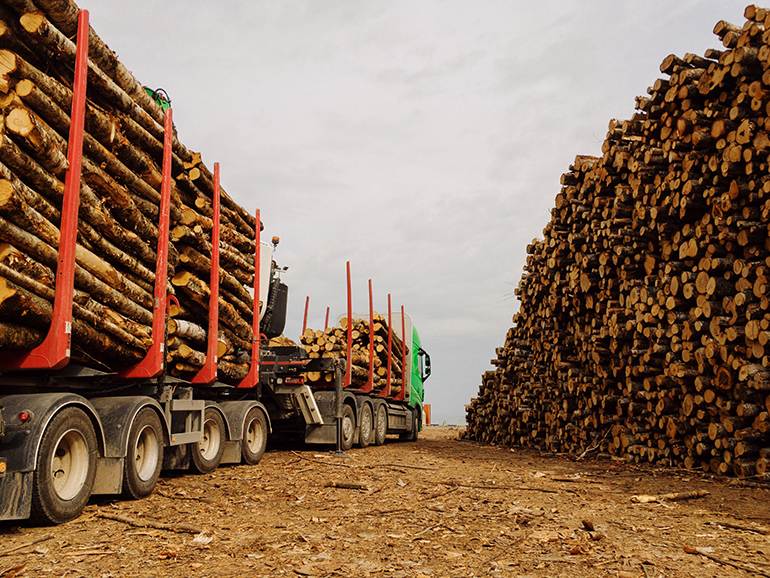
| courtesy of Adobe Stock
HILA basics
The HILA generates long actuator strokes from a short cylinder body. It is based on well-known hydraulic clamping technology, where the piston and rod can be coupled and uncoupled by means of a clamping element. The HILA actually combines two short-stroke cylinders with two coordinated, engaging and disengaging clamping mechanisms into one actuator with a long stroke length.
The motion of each single short-stroke piston, linked together by the internal clamping mechanisms, drives the piston rod. One piston at a time connects to the rod, shifting the load from one cylinder to the other and alternatingly moves the rod in a kind of “hand-over-hand” rope climbing motion. Simple logic valves control the flow.
The clamping mechanism, essentially a hydraulically activated membrane, maintains friction and load-holding capacity. It is pressurized and engaged by a separate port through the piston using a dedicated 3/2 valve. Here, minimal flow is needed to pressurize the small membrane volume, so a small and fast-operating valve can be used. Piston movement and clamping actions are independently controlled by a timing procedure. (Readers can view the actuation process at www.youtube.com/watch?v=tVJkqC2w5ws.)
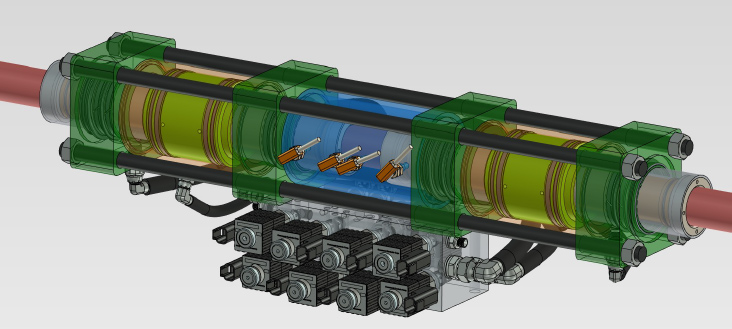
| courtesy of Gustav Näslund, GN Tech
Because piston areas in the cylinders are symmetrical, there is marginal variation of oil volume during operation, compared to conventional hydraulic actuators. Another advantage is that the system needs only a fraction of the hydraulic oil versus an ordinary long-stroke hydraulic cylinder and, thus, requires a much smaller oil reservoir.
One challenge is to generate linear motion with a low pulsation level. In many applications, however, smaller pulsations are acceptable. The technology is best suited for applications with relatively slow dynamics and where movements are largely kinematic and well-understood.
In contrast, traditional long-stroke cylinders face several hurdles. Buckling is probably the main problem. It can be overcome in some applications using a pulling cylinder. Hydraulic stiffness and hydraulic capacitance can also have an unfavorable effect on dynamic behavior and controllability. Longer hydraulic cylinders usually face difficulties at high pressure, as it reduces the system natural frequency. Thus, advantages normally associated with hydraulics — compactness and high power density — diminish with increasing stroke length.
The Hydraulic Infinite Linear Actuator solves these problems. HILA provides long strokes at high system pressure, with a higher stiffness compared to conventional hydraulic cylinders. Each HILA cylinder has a much shorter body, so a sufficiently high natural frequency can be achieved at high system pressures. And bulk modulus increases slightly with increasing pressure. These are favorable factors in terms of actuator control design.

The compact and lightweight system, built with robust and cost-effective standard components, is well suited for tough and demanding environments, especially in mobile applications, where there presently are no alternative solutions.
Strokes as long as 7 to 8 m (23 to 26 ft) are possible, depending on the piston rod diameter, for pulling loads in horizontal applications. Even longer strokes can be implemented in vertical applications, such as in elevators. As the HILA technology needs small cylinders and low oil volumes, it is possible to design compact and long stroke electro-hydraulic actuators (EHA). Symmetrical piston areas simplify the design.
HILA technology also lets several active actuators to be positioned and locked on the same piston rod, which can be advantageous in certain applications. This means that several processes can be performed in parallel instead of serially, without the need for a dedicated actuator for each element. Here’s a look at two such applications. One involves timber vehicle aerodynamics and logistics; the other shows how HILAs can flexibly and optimally position row units on agricultural planters, to secure productive and sustainable farming.
More-efficient timber trucks
There is a great need in forestry transport to reduce fuel consumption and limit variable costs and carbon dioxide emissions. One solution is to develop larger vehicles that carry greater loads and reduce transport cost per mile.
There are likewise opportunities to improve vehicle aerodynamics, as air and rolling resistance are two of the most important factors that hurt fuel economy. Truck manufacturers put a lot of effort into reducing air resistance through better aerodynamic design of the cab and chassis. For the trailers, no similar development has taken place.
Complicating matters, a timber trailer is like two completely different vehicles, loaded and unloaded. When unloaded, several points experience strong turbulence, specifically around the vertical stakes that support the logs; and around the horizontal banks — the structural cross-members that hold the stakes in place and on which the logs sit.
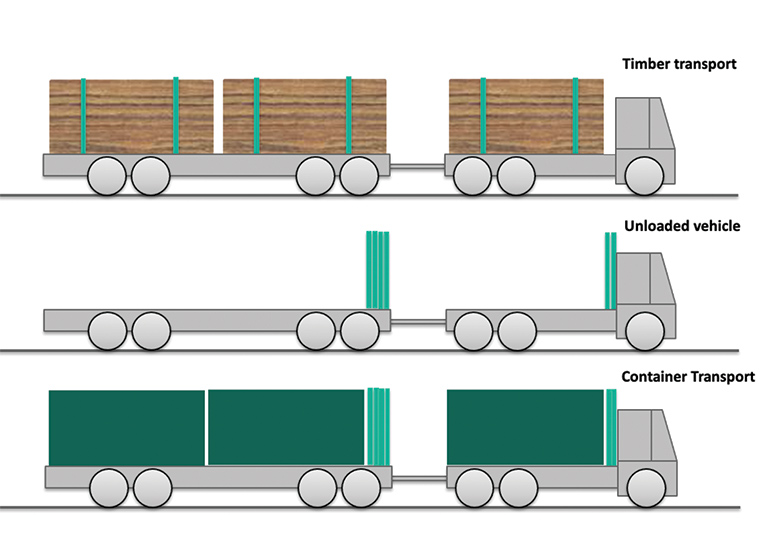
Simulation studies show that the biggest aerodynamic problems for unloaded timber trucks are turbulence under the trailers, and air resistance due to stakes and banks that stand upright in the air stream. Bundling stakes and banks together at one point would significantly reduce air resistance, depending on vehicle speed. The trend is toward timber vehicles that drive longer distances at higher average speeds, due to fewer and larger sawmills and pulp mills. As air resistance increases with the square of the speed, the need for consolidated banks and stakes is even more important for fuel economy.
The same holds for aerodynamic resistance and turbulence that banks and stakes create on unloaded timber train carriages. While unloaded timber trucks drive at maximum speeds of around 100 km/hr (60 mph) in the U.S. and Canada, freight trains travel at even higher speeds. Studies show that covering unloaded coal wagons can reduce air resistance by more than 40%.
HILA advantages
HILA systems can address these issues. With HILA technology, banks and stakes on timber vehicles can be individually positioned, automatically, with high locking force. The system can also significantly increase vehicle flexibility and open up more combinations that facilitate cost-effective and environmentally friendly logistics for both timber and complementary goods flow. Key functions on towing vehicles and timber trailers include:
- Bundling of banks and stakes for better aerodynamics. Consolidating banks and stakes at one point on the trailer or behind the cab will reduce air resistance and, thus, cut fuel consumption and carbon dioxide emissions by about 5%, according to a study of forest vehicles by C. Löfroth and O. Gelin. Use on timber trains can produce similar benefits.
- Enable different bank and stakes combinations. Today’s timber transports are also characterized by a great variation in timber length, which can change with each trip. Thus, there is a need to combine different-length stacks, from 2.6 to 6 m (8.5 to 19.7 ft) on the same vehicle. The HILA actuator lets operators switch bank combinations to accommodate different timber lengths, based on the number of stacks and the length of wood on each stack.
Timber trailers can have up to eight banks. With HILA actuator technology, adjustment between 2, 3 and 4-stack combinations can be done smoothly via an in-cab display. This eliminates the difficult and hazardous manual work needed to push the heavy banks and stakes between various positions, significantly improving driver safety and saving considerable time.
- Bank shifting. In addition to lowering air resistance and fuel consumption, it is also important to minimize the empty weight of vehicles. Most timber trucks that load with their own crane have a bank shifter, a hydraulic cylinder that moves the banks forward for loading. Because the crane has a limited range, one stack is loaded and then pushed back to load the next. The typical bank shifter is a 4 m (13.1 ft) long hydraulic cylinder that weighs 400 kg (880 lb) and requires a large hydraulic tank. A compact HILA system at about half the weight (200 kg) with a smaller hydraulic tank can readily perform the same task and generate actuator forces up to 170 kN (38,000 lbf).
- Adjustable center of gravity. Center of gravity balancing of stacks is important to get the proper weight distribution and avoid overloading any axle group.
- Gap-filling. Minimizing gaps between stacks reduces air resistance of a loaded vehicle and improves the torsional rigidity of the trailer.
- Easier inspection. HILA can quickly disassemble stacks and facilitate inspection.
- Allow for complementary cargo. With HILA technology, towing vehicles, trailers and trains can easily be repurposed to carry 20 to 40-ft shipping containers. This creates opportunities for valuable complementary freight flow and large savings with respect to time, costs and climate impact, especially on long transport routes.
Precision seed drills
A key to productive and sustainable farming is planting seeds at an optimal distance from each other. However most present seeders have a fixed row distance and, thus, low adaptability for different crops or soil conditions. Even when possible, changing row spacing is time consuming and expensive, as it can take two working days to manually adjust row spacing on a precision seed drill. Further, the machine is out of production, especially critical in the spring planting season.
One possible solution for variable row spacing is to densely pack seeding units on the machine arms and only activate certain ones to obtain the proper row spacing. But driving around with excessive dead weight is impractical.
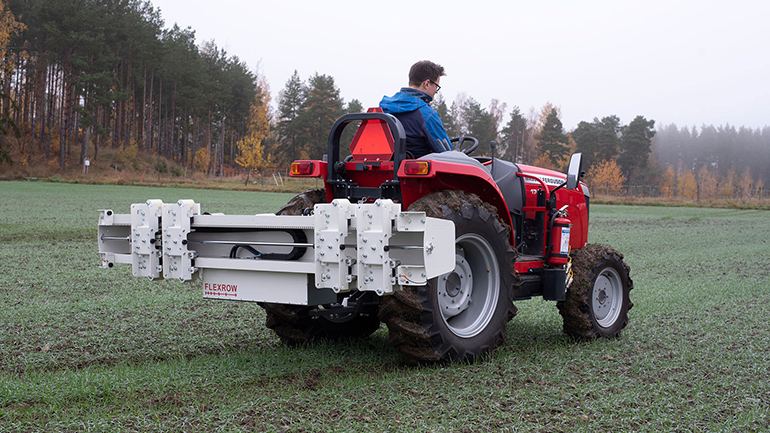
HILA technology enables numerous seeding elements to be positioned along a row, with high locking force. Operators can implement fast, efficient, and variable row spacing on machines for precision sowing, inter-row cultivation and crop harvesting. This means that the same machine can be used for different crops and meet farmers’ demands for common multi-purpose equipment.
A HILA can quickly shift the position of drill units as needed. Operators can vary the distance between drill units from a display in the tractor cab, and fine-tune the inter-row spacing depending on the types of crops and soils. The HILA concept allows for countless configurations for different seeds, and spacing can be independently adjusted with high precision.
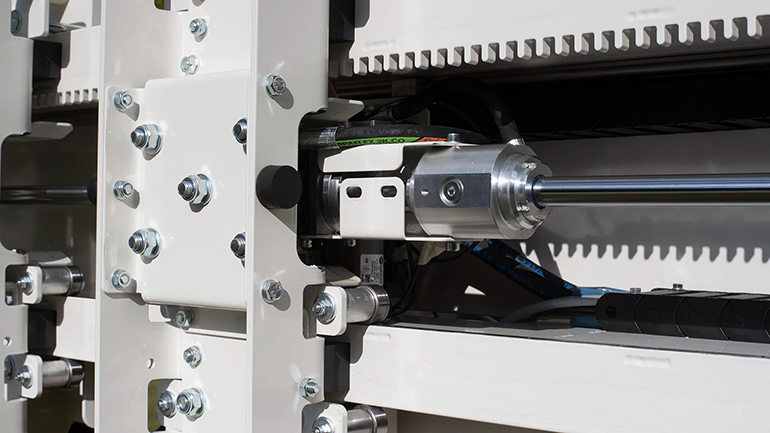
| courtesy of Per Frankelius, Linköping University
Operators can also reconfigure spacing on-the-fly if one unit fails, so planting can continue without having to wait for a service technician. This contributes to higher productivity. Similarly, for easier servicing, it is possible to open large spaces around a specific row unit with the push of a button.
While it is beyond the scope of this article, HILA technology can also let operators vary the arm width of seed drills and planters, and fold the arms for transport on roads. It offers the possibility of longer arms and a simpler and faster folding mechanism, with a more optimal center-of-gravity, more stable vehicle dynamics and higher travel speeds.
A demonstrator has been successfully tested and meets the initial functional requirements. The next step will be to build a full scale seed drill. As part of Sweden’s Agtech 2030 innovation program, the project involved collaboration among Saab Ventures, Sweden’s Rural Economy and Agricultural Societies, GN Tech, and Landberg Solutions. The hydraulic research division (FLUMES) at Linköping University has been instrumental in this work.
Landberg Solutions AB | flexrow.com
Filed Under: Cylinders & Actuators, Fluid Power World Magazine Articles, Mobile Hydraulic Tips